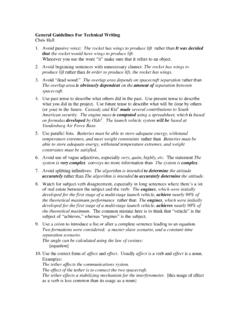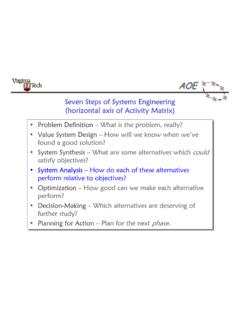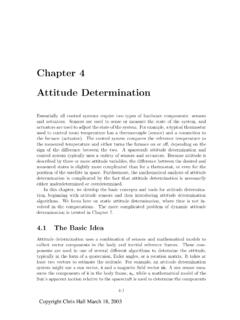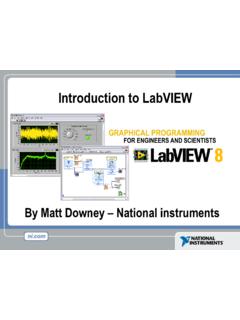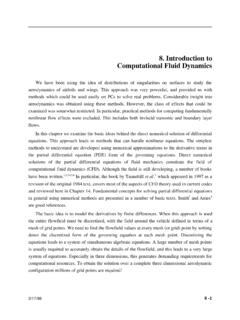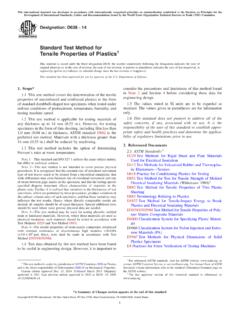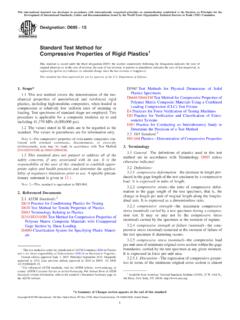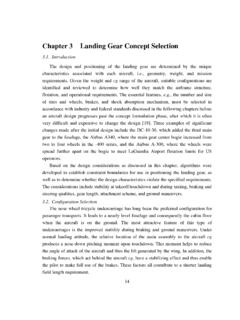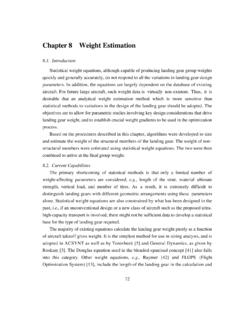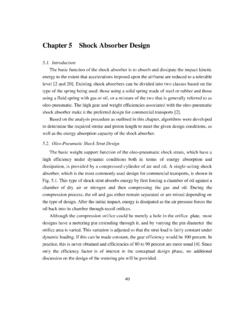Transcription of Roll and Yaw Moments and Stability Yaw Moment Equation (1)
1 Roll and Yaw Moments and StabilityYaw Moment EquationThe yaw Moment is the Moment about the zbodyaxis and is positive if it moves the nose ofthe plane to the right. The big contributor to the yaw Moment is the vertical tail. We can writethe yaw Moment Equation in a similar manner to the way we wrote the pitch- Moment Equation byconsidering the contributions from the wing-body combination and from the vertical tail. If wetake Moments about the center of gravity we have:(1)whereis the vertical tail length, the distance from the cg to the aerodynamic center of thevertical tail,are the lift and drag of the vertical tail, andis the angle of attack of thevertical tail measured positive so as to create a positive side force. If we make the usualassumptions such as thatis a small angle, and that, we can reduce Eq.
2 (1) to theform:(2)and(3)whereis the vertical tail area. Dividing bywe obtain the yaw- Moment Equation incoefficient form:(4)If we let the vertical tail lift coefficient depend on a vertical tail lift curve slope and a rudderdeflection we can write it as:(5)whereandare the vertical tail lift curve slope and rudder lift curve slope respectively. Inaddition we can write the vertical tail angle of attack in terms of the vehicle side slip angle,,and the side-wash angle,, as:(6)If we make the substitutions, the yawing Moment Equation takes the form:(7)We can put this Equation in a more useful form by determining the Stability and controlderivativesand. Taking the derivative of Eq. (7) with respect to$and, we have(8)and(9)With these expressions for the Stability and control derivatives, Eq. (7) can be rewritten in theconvenient form:(10)Rudder ConsiderationsWhat is a rudder for?
3 There are several purposes for a rudder on an aircraft. Theseusually drive the sizing of the rudder. The four dominant needs for a rudder are:1) To counter yawing Moments due to propeller slip stream effects, especially at highangle of attack and low speed. This effect is sometimes called the p p effect is caused by the asymmetric loading of the propeller due to theangle of attack. The down moving blade (on the right side) sees a bigger angle ofattack than the up-moving blade on the left side. Consequently there is more thruston the right side than the left. In addition, the torque of the engine driving thepropeller requires more lift on the left wing then the right, causing more induceddrag on the left wing adding an additional left yaw Moment . Further, the rotationof the air behind the propeller causes more of a sidewash on the vertical tail fromthe left, causing an additional nose left yaw Moment .
4 All these yaw Moments mustbe countered with the ) To counter adverse yaw. When turning to the right, the left aileron is down, and theright aileron is up. This alignment causes the left wing to have more lift and hence moredrag. Hence even though one wants to turn right, the ailerons cause a left yaw Moment must be countered by the ) To counter asymmetric thrust. If one engine goes out on a multi-engine aircraft, thenthe rudder is used to counter the resulting ) To assist in cross wind landings. The one time that it is desired to fly with a sideslipangle is during a cross-wind landing. Here the yawing Moment due to the sideslip angle iscountered by using the Rudder Sizing for Asymmetric ThrustA quick and dirty method for sizing the rudder for asymmetric thrust can be achieved byusing just the yaw Moment Equation and ignoring the roll and sideforce equations .
5 Under thesecircumstances we can consider countering the yawing Moment due to asymmetric thrust with justthe rudder. The yaw Moment due to asymmetric thrust is given by(11)whereTis the thrust of the good engine, andis the Moment arm along the y axis to that associated yawing Moment coefficient is given by(12)whereis the reference area for the thrust coefficient,. (Note that since enginemanufacturers do not necessarily know in which vehicles their engines will be installed, theyoften use their own reference area,, to base their thrust coefficient).The yaw- Moment Equation can be modified to include this additional term.(13)Generally, we will require the sideslip angle,$, to be zero (to minimize drag with the engineout), so we end up with the Equation for sizing the rudder as:(14)Free Rudder (Stick Free)If the rudder control is released, the rudder is free to swing if the control system isreversible.
6 If the system is irreversible, the rudder will stay where it is put. In a reversible system,freeing the stick is equivalent to setting the hinge Moment equal to zero. The hinge Moment isgiven by:(15)If we assume, and ignore the rudder trim tab, then we can determine the free rudderangle:(16)Then we can arrive at the free rudder factor in a manner similar to how we developed the freeelevator factor for the longitudinal case. The result is:(17)We can now replace the vertical tail lift-curve-slope with the modified valuefor the case where the rudder is free. The resulting equations are then for thestick-free case. Hence we have the stick free weather-cock Stability parameter:(18)The stick force is given by:(19)and the stick force gradient by:(20)EstimatingThe expression for the weathercock Stability parameter is:(21)We can separate the wing-body contributions into two parts, the contribution from the fuselage,and the contribution from the wings.
7 From Perkins and Hage, we can write the contribution fromthe fuselage as:(23)where:= projected side area of fuselage= overall fuselage length= height and width of fuselage at(quarter fuselage location)= height and width of fuselage at(3/4 fuselage location), where = distance from nose to cg locationFurther, the following table gives values foras the ratio of the length of the fuselage over itsgreatest height. Here,his the greatest height of the fuselage measured to a faired curve neglecting the bump due to the wing contribution to the weathercock Stability parameter is given by a DATCOM expression(also found in Etkin and Reid) as: [for low speed (incompressible ) flight](24)The units in this Equation are /rad>To account for compressibility effects, we must correct the above expression by multiplying it bythe correction factor:(25) Tail ContributionThe vertical tail properties such as the lift curve slope are determined in the same manneras for the wing and horizontal tail.
8 The only difficulty is arriving at an aspect ratio for the verticaltail. We can define two aspect ratios, a geometric aspect ratio and an aerodynamic effectiveaspect dimensions of the vertical tail can be measured in several ways. For uniformity wecan define the root chord to be the chord of the vertical tail if it were projected to the referenceline (typically the centerline) of the fuselage. The vertical tail span is then the distance from thecenterline to the tip of the vertical tail and is designated as. The area of the vertical tail,isthen the area between the root chord and the tip chord. We can now define the two aspect ratiosindicated Aspect Ratiois determined by reflecting the tail about the reference lineand calculating the aspect ratio of the (imaginary) resulting symmetric vertical surface.
9 Using thedefinitions of the area and span of the vertical given previously, we have the geometric aspectratio given as:(26)This is the aspect ratio that should be used in all calculations that involve the geometry of thevertical tail such as sweep angles, and location of mean aerodynamic or Aerodynamic Aspect Ratiois the aspect ratio on which aerodynamicproperties are based such as the lift curve slope. An approximation to the aerodynamic aspectratio is given by (from Perkins & Hage)(27)This value is smaller than the geometric value and reflects the fact that the half span is lessefficient than the full span. However it is not as inefficient as a half span lifting surface by itselfwould be because the fuselage acts as an end plate making the surface slightly more this value represents a compromise.
10 This is the value to be used in calculating the verticaltail lift curve slope:(28)The remaining part of the vertical tail contribution can be determined from theDATCOM. The term we need to estimate is:(29)where= distance from wing root quarter chord to fuselage centerline in feet, (zwpositivedown, the wing would be below the centerline for = maximum fuselage heightRoll MomentThe roll Moment is designate with an L. Sometimes to avoid confusion with lift we willdesignate it with an Lroll. The roll Moment coefficient is defined as:(30)If we consider static Stability in roll, we seek a restoring force for a displacement in the rollangle. If we look real carefully we find there is there is no direct static Stability inroll!However, we can look a a secondary effect due to roll. If we think of a pure disturbance inroll, we will note that the aircraft rolls, and the lift vector rolls with it (assuming angle of attackand sideslip angle are unchanged- otherwise it would be a pitch or yaw disturbance!))
